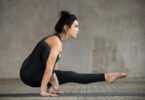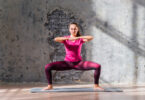Introduction to hot yoga
Hot yoga has surged in popularity thanks to its intensive approach and the unique benefits it offers. This guide will explore what hot yoga entails, how to find local studios, and why it might be the perfect addition to your fitness routine.
What is Hot Yoga?
Hot yoga involves performing yoga poses in a room heated to around 105°F with 40% humidity, creating a challenging yet rewarding environment for practitioners. Learn more about yoga basics for seniors.
Benefits of Hot Yoga
This yoga style improves strength, flexibility, cardiovascular health, mental endurance, and stress reduction. It’s particularly beneficial for senior women seeking to maintain an active lifestyle, which is why senior women should consider yoga.
How to Find the Best Hot Yoga Studios Near You
Finding the best hot yoga studio near you involves several steps to ensure that the studio meets your needs in terms of quality, atmosphere, and convenience. Here are some tips to help you find the best hot yoga studios in your area:
- Research Online: Search online for hot yoga studios near your location. Use search engines, yoga-specific websites, and platforms like Yelp and Google Reviews to see ratings and reviews from other yoga practitioners. This can give you a good sense of the most popular and highly regarded studios.
- Check Social Media: Look at the social media pages of local yoga studios. These often provide insights into the studio’s community, the types of classes they offer, and any special events or promotions. Instagram, in particular, can be helpful to see the studio’s environment and the engagement of its members.
- Ask for Recommendations: Talk to friends, family, or colleagues who practice yoga. Personal recommendations are invaluable as they give firsthand accounts of people’s experiences with the quality of instruction, the rooms’ heat levels, and the studio’s overall vibe.
- Consider the Location and Schedule: Ensure the studio is conveniently located and offers classes at times that fit your schedule. Proximity and convenience are key to maintaining a consistent yoga practice.
- Visit the Studios: If possible, visit several studios to see the facilities in person. Pay attention to cleanliness, the condition of the yoga mats and other equipment, the changing rooms, and the overall atmosphere.
- Trial Classes: Many studios offer discounted trial classes or introductory offers for new students. Take advantage of these to experience a class firsthand. This allows you to assess the teaching style, the intensity of the workouts, and whether the studio meets your expectations.
- Check the Credentials: Ensure the instructors are certified and have experience in teaching hot yoga. The instructors’ qualifications and professionalism significantly impact the classes’ quality.
- Look for Additional Amenities: Some studios provide showers, lockers, or a lounge area. While not essential, these amenities can enhance your overall experience, especially if you plan to go straight to work or another event after class.
- Safety and Comfort Measures: Ensure the studio follows appropriate safety measures, especially in managing the heat and ensuring adequate ventilation. Also, check if they offer options like rental mats, towels, and water.
- Evaluate the Cost: Finally, consider the cost of classes, membership fees, and any additional charges. Some studios might be more expensive but offer more classes or better facilities.
What to Expect in a Hot Yoga Class
Participating in a hot yoga class can be an intense but rewarding experience, especially for those looking to enhance their flexibility, strength, and mental focus under challenging conditions. Here’s what you can generally expect when attending a hot yoga class:
- High Temperatures: The most defining feature of hot yoga is the heat. Studios typically heat the room to between 95 to 105 degrees Fahrenheit (35 to 40 degrees Celsius) with a humidity level of about 40% to 60%. The high heat helps to warm up the muscles more quickly and makes the body more flexible.
- Sweating: Due to the high temperatures, expect to sweat a lot. Sweating is intended to help detoxify the body and allow you to stretch deeper into poses. Be prepared with a towel (or two) and plenty of water to stay hydrated throughout the session.
- Pacing and Intensity: Hot yoga classes can vary in pace depending on the style. Some classes are based on Bikram yoga, which consists of a specific series of 26 postures and two breathing exercises. Others may be more flow-based, like hot Vinyasa, where the movement is synchronized with breath continuously.
- Breathing Exercises: Breathing exercises are a crucial part of hot yoga as they help manage the challenges of heat and maintain focus. You’ll likely begin with deep breathing to acclimate to the temperature and end with cooling breaths to normalize body temperature.
- Physical Challenge: Hot yoga is physically demanding. The heat enhances muscular flexibility, making it easier to achieve deeper stretches, but it also increases the challenge as you try to maintain balance and strength in poses.
- Duration of the Class: Most hot yoga classes last about 60 to 90 minutes. During this time, you’ll go through a series of poses designed to work different body parts comprehensively.
- Common Poses: Expect a range of poses, including standing poses, balance poses, twists, backbends, and floor work. Each pose is typically held for some time to deepen the stretch and improve endurance.
- Mental Focus and Meditation: Hot yoga not only challenges the body but also focuses on calming the mind. Under intense physical exertion, instructors often emphasize staying present and mindful throughout the practice.
- After the Class: You might feel tired but incredibly rejuvenated after a hot yoga class. Many practitioners report enhanced mental clarity and heightened relaxation following the session.
- Preparation and Aftercare: It’s essential to come to class hydrated and drink water afterward to replenish fluids lost through sweating. A light meal a few hours before class can provide energy without causing discomfort. After class, taking a cool shower and continuing to hydrate are crucial to recovery.
Preparing for Your First Hot Yoga Session
Preparing for your first hot yoga session is crucial to ensure a safe and enjoyable experience. Here are some practical tips to help you get ready:
- Hydrate Beforehand: Drink plenty of water throughout the day before your class. Hydration is vital to help manage the heat and minimize the risk of dehydration due to intense sweating. Avoid drinking too much right before class to prevent discomfort.
- Eat Lightly: Eat a light meal 2-3 hours before your session. Choose foods that are easy to digest, like a banana, a small yogurt, or a handful of almonds. Avoid heavy, fatty, or spicy foods that might make you uncomfortable.
- Bring the Right Gear: Pack a large water bottle, two towels (one for your mat and one for wiping off sweat), and a yoga mat. Some studios rent mats and towels if you don’t have your own.
- Wear Appropriate Clothing: Choose breathable, moisture-wicking workout clothing. Avoid loose clothing as it can get in the way during certain poses. Women might prefer sports bras and leggings, and men might opt for compression shorts or swim trunks.
- Arrive Early: Get to the studio 15-20 minutes early to acclimate to the heat and settle in. This time allows you to fill out any necessary forms, meet your instructor, and secure a spot where you feel most comfortable.
- Set Realistic Expectations: Feeling overwhelmed by the heat or finding some yoga poses challenging is normal. Focus on doing what you can and listen to your body. Rest when needed and avoid comparing yourself to others in the class.
- Position Yourself Wisely: For your first class, you might want to set up your mat near the back of the room. This allows you to follow the lead of more experienced practitioners and makes it easier to step out if you need a break.
- Stay Hydrated During and After Class: Continue to sip water throughout the class as needed. After the class, rehydrate with water or an electrolyte drink to replenish lost minerals and fluids.
- Cool Down: After class, if possible, take a cool shower. This helps regulate your body temperature and rinse off sweat, which can be refreshing and invigorating.
- Reflect on Your Experience: Spend some time reflecting on your feelings after class. It’s common to experience a range of emotions and physical sensations. Note what you enjoyed about the class and what was challenging.
The Community Aspect of Hot Yoga
Hot yoga isn’t just about physical health; it’s also about building community.
Sharing the Experience with Others
Many find sharing the challenging environment of hot yoga with others to be a bonding experience.
Community Events and Workshops
Participate in community events and workshops to deepen your practice and connect with fellow yoga enthusiasts.
FAQs
Is hot yoga better for you?
Hot yoga is not necessarily better or worse than other forms of yoga but offers different benefits. It can improve flexibility as the heat helps muscles relax more quickly and allows a deeper stretch. It also enhances cardiovascular conditioning because the body has to work harder in a hot environment, which can help improve heart health over time. Additionally, the intense sweating is believed to help flush toxins from the skin. However, the high temperatures might not suit everyone, particularly those with specific health issues such as heart problems or skin conditions.
How many times a week should you do hot yoga?
The frequency of hot yoga sessions can vary depending on your overall fitness level, goals, and how well your body adapts to the heat. For beginners, it might be advisable to start with once a week to see how the body reacts. You might increase this to 2-3 times a week as you become more comfortable and conditioned to the heat. Always ensure that you give your body time to rest and recover, as the intense nature of hot yoga can be taxing.
What is hot yoga also called?
Hot yoga is often associated with Bikram yoga, pioneered by Bikram Choudhury, and consists of 26 postures performed in a heated room. However, any yoga practice in a heated environment is generally called hot yoga. There are variations like Moksha yoga (known in the U.S. as Modo yoga), which also involves a series of postures in a heated room but focuses more on environmental consciousness.
Is hot yoga hard for beginners?
Hot yoga can be challenging for beginners, mainly due to the high temperatures, which can initially be uncomfortable or overwhelming. The heat makes the body sweat profusely and can lead to issues like dehydration if not careful. Also, maintaining or holding postures in such conditions can add a layer of physical challenge. However, many find that with regular practice, their heat tolerance improves, and they become more accustomed to the workout intensity. Beginners must pace themselves, stay hydrated, listen to their bodies, and take breaks when needed.
Conclusion
Hot yoga offers numerous benefits and can be a rewarding addition to your fitness routine. Whether you want to improve your physical or mental health, hot yoga provides a unique environment to achieve your goals.
Whether you’re a beginner or a seasoned yogi, hot yoga offers unique benefits and challenges. To start your hot yoga journey, check out the best yoga studios for seniors across the U.S.







